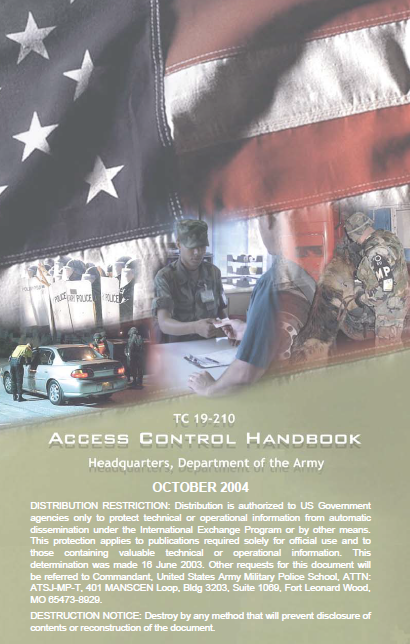The following document was posted online in October on the file-sharing website 4shared.
TC 19-210 Access Control Handbook
- 137 pages
- Distribution is authorized to US Government agencies only to protect technical or operational information from automatic dissemination under the International Exchange Program or by other means.
- October 2004
This handbook provides installation commanders with the basic information necessary for effective access control to their installations. It does not discuss the technical issues involved with standards and designs. Information regarding standards and designs is evolving and will be resolved by the Headquarters (HQ) Department of the Army (DA) PS Review Board (DAPSRB) and the PS integrated concept teams. This handbook provides commanders with the legal and jurisdictional issues associated with the inspection procedures at an ACP. Additionally, this handbook equips operators (which includes military police [MP], DA police, and sentinels of augmenting units) of an ACP with the various vehicle inspection criteria and measures necessary to conduct an effective ACP.
The openness of the United States (US) society provides an opportunity for our enemies to operate with more freedom than they would have in more restrictive venues. Also exacerbating the threats is the global proliferation of cheap weapons of mass destruction (WMD) and the means to disseminate knowledge about such weapons. Few US cities are fully prepared to deal with incidents involving WMD. Critical infrastructure and the US economy are becoming increasingly more reliant on information and computer-based technologies that are vulnerable to covert attacks. Many military installations and facilities are key force projection platforms and are susceptible to attacks from terrorists using WMD, from unconventional special forces formed from elements infiltrated into the United States, or from indigenous hostile elements.
As a result of recent events, Army installations have increased their force protection (FP) readiness through increased access control operations. Access control is a major implied security mission that supports the installation FP program. The FPCON determines the level of operation at an ACP, and thus, the ACP must be able to quickly and easily enhance security under an increased FPCON. ACPs serve as the access point for all personnel, vehicles, and deliveries to an installation. The ACP becomes the first chance for forces to inspect incoming personnel, vehicles, and cargo in order to detect, assess, and deter an incident.
Installation commanders must establish installation access control procedures that comply with Department of Defense (DOD) and DA policies. In addition to these policies, installation commanders must consider—
- Manpower availability.
- FPCON.
- ACP layout.
- Other factors, all of which will influence a commander’s manning level for an access control operation.
When considering installation access control, commanders must reflect on its purpose, the impact on the surrounding community, and the end state. The purpose of access control is to identify, reduce, or eliminate installation and in-transit vulnerabilities to threats and to enhance the overall FP posture while minimizing the impact on normal operations. The end state is to protect the forces through a myriad of measures that are addressed in the installation access control plan. FPCON levels and access control measures are established in a graduated scale based on the intelligence provided by a threat fusion cell.

